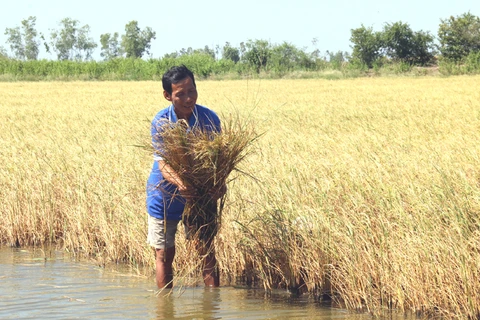Quang Binh (VNA) – More than 15,000 households in 14 cities and provinces who announced natural disaster status, have received initial support from the Vietnam Red Cross Society (VRC).
Vice President of the VRC Central Committee Tran Thi Hong An told an April 27-28 event, that by April 24, 2016, the organisation had mobilised over 25 billion VND (1.1 million USD) donated by people from all walks of life to aid natural disaster victims.
The conference, jointly held by the VRC, the German Red Cross (GRC) and the VRC’s chapter in Quang Binh province, aims to assess the risks and impacts of climate change and how red cross activities can work in response to climate change.
As part of the GRC-funded “Community-based disaster risk management” project, the event is due to create an opportunity for the VRC, and relevant agencies, to promote the integration of climate change adaptation into the management of risks and disasters in Vietnam.
It is expected to enhance coordination between ministries, agencies, localities, organisations at home and abroad, and partners of the International Red Cross and Red Crescent, in disaster mitigation and climate change adaptation.
Delegates will focus on practical activities and solutions to deal with the problem in the context that climate change is becoming a headache to Vietnam.
Vietnam is one of the countries hardest hit by climate change globally, with the most obvious evidence being the severe drought and saltwater intrusion in the central, Central Highlands and Mekong Delta regions.
The Southeast Asian nation has to grapple with up to 15 storms and floods each year, which have in recent years seriously affected half of the land and over 70 percent of the population in disaster-prone areas.
In 2013 alone, a total of 14 storms and floods swept through the country, affecting more than 4 million people – the highest ever recorded in the past decade.
According to the Central Steering Committee on Natural Disaster Prevention and Control, the rainfall in the Central Highlands and south central region from late 2015 to the present is very low, with hydropower reservoirs containing much less water than their designed capacity, and some small reservoirs even being dried out.
The drought has effected some 70 percent of the cultivation areas in these regions, with Dak Lak, Gia Lai, Kon Tum, Ninh Thuan and Binh Thuan being the hardest hit.
Saltwater has intruded as far as 90km inland in the Mekong Delta, about 10-25km farther than usual.
Up to 11 out of the 13 cities and provinces in the delta were affected by salinity which caused serious water shortages and damaged agriculture production.
As of April 13, 2016, more than 390,000 households in the Central Highlands, Mekong Delta and south central region were faced with water shortages. Drought and saltwater intrusion damaged over 232,000 ha of rice, 61,992 ha of fruit, and 4,052 ha of seafood. The total economic loss was estimated at over 5.1 trillion VND (229.5 million USD).-VNA
























